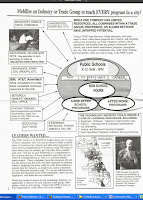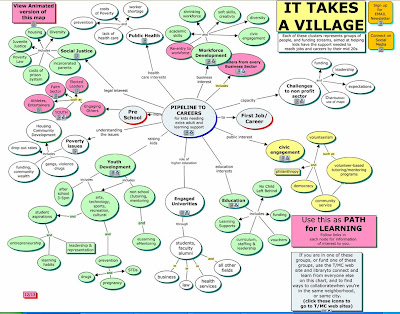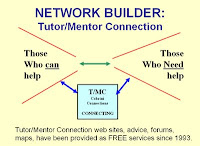You can see by this example that I was using graphics to illustrate that youth living in high poverty neighborhoods need support in the non-school hours, not just during the school day hours.
You can also see that I was using maps to show places with high poverty where well organized programs are most needed. This need has not changed although the number of African American's living in some of Chicago's high poverty neighborhoods has declined dramatically since 1993.
So, who should be looking at this information? Everyone who lives or does business in the Chicago region! That's who. This graphic illustrates this idea.
Everyone can do something with the ideas I share, if it's only that they pass them on to others. The graphic above not only illustrates the idea, but it's also a tool and a worksheet. At the bottom of each node is a box that either links to another concept map, or to an external web site. If the external links in each box point to leaders in each focus area, who adopt this strategy map, and help implement the strategies shown on my web sites, we'll have a tool that gives recognition to those who are leading this effort, and provide models that others can follow.
We'll have a growing "village" of leaders who focus on a common goal, and share a commitment to common actions that need to be repeated over many years.
Below is another graphic, that illustrates my role.
I fill an intermediary role (the blue box). The information I share in blog articles and in the Tutor/Mentor web library can be used by anyone to expand their understanding of how concentrated poverty is a root cause of many inequalities and of ways they can use their personal, or organizational, resources to help build systems of support that help kids in a single neighborhood, an entire city, or in many cities.
So, why have I not had more impact. Why am I working from my basement and donated space in the city and paying to keep these resources available through my own savings?
I created this graphic a few years ago. It shows that over the past 25 years I've consistently communicated these ideas, and have drawn support from many businesses and foundations and volunteers. However, there have been major "dips" in support, such as in 2000 when my major donor and supporter, the Montgomery Ward Corporation, went out of business. Or in 2000 when the dot-com bubble burst and many donors cut back on funding. Or 2001 after 9/11, when the stock market plunged and additional donors cut back on funding.
Then in 2008 when the financial markets collapsed, and we lost major corporate support from HSBC North America and from others. Finally in 2011 when the Board of Directors at the organization hosting the Tutor/Mentor Connection, decided to discontinue support for the strategy, and I created the Tutor/Mentor Institute, LLC to try to keep it going in Chicago and share it with other cities.
I've posted many articles showing challenges facing non profits, on this blog, and in this section of the web library. If I were to provide a list of grants received from 1994 through 2011, it would show that most only lasted one year to three years. This is a 25 year journey. It takes that long for each youth to move from birth to work. Innovating new solutions to funding would be a huge step toward reducing poverty by providing greater paths to opportunity.
I posted this Chicago SunTimes story from 1993 in my blog in April 2015. We're now in 2016 and face the same challenges, with the same lack of a comprehensive battle plan....including a plan that generates an on-going flow of talent and dollars into every poverty neighborhood. That's what this article focuses on.
The ideas I share can be used by leaders in any city to support a common vision, and commitment to fill poverty neighborhoods with comprehensive, on-going programs that surround kids with learning, mentors and a strong support system that helps them move through school and into jobs.
I keep looking for a benefactor who understands my role and will provide the financial resources to help me continue to spend time daily learning what others are doing, adding this to my library, and sharing ideas that they can use. Such a benefactor would also help me move the Tutor/Mentor Institute into a college or other structure where it will continue to be a resource in future years.
Anyone in "the village" can share this idea.













No comments:
Post a Comment